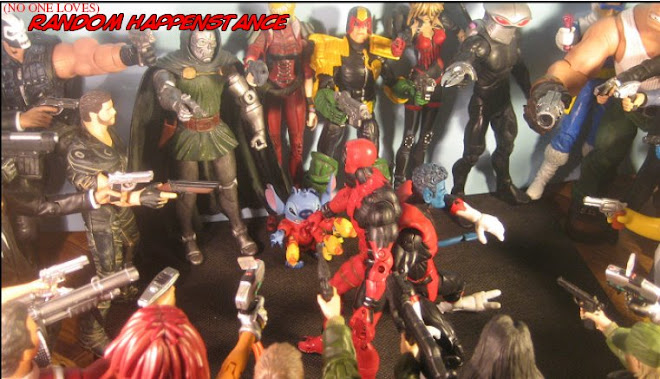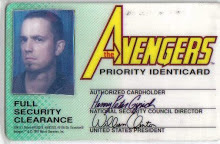So, after several years at this apartment, I finally bought some shelves for the garage; and already it's making finding comics so much easier. Instead of box piled atop box atop box...well, some of those boxes are now on shelves, and there's enough room to stand in there. Why, I found my longbox of
Deadpool comics! Although I'm short an issue or two, I read his first regular series, not quite from the beginning, but from issue
#6. And I picked up that issue, because of the Vamp. (I'm sorry, the who?)

From 1997,
Deadpool #6, "Man, Check Out the Head on That Chick!" "Headgames" by Joe Kelly, "Headaches" by "Head" McGuinness, "Headlines" by Norman Lee and Nathan Massengill. This was early on in Kelly's character-making run on the book, and Pool just wrapped a storyline with his persistent crush-object, X-Force's Siryn.

After a bit of b-ball with Blind Al (with Pool in a Scarlet Spider hoodie!) Pool heads down to the Hellhouse to take a gander at any merc work opening up. With his tech-support pal Weasel, they find a job offer two-fer: break a woman out of the asylum, then kill her. Either-or, or both.

Using his image inducer, and with Weasel pretending to be "convinced he's
Ricki Lake!," Deadpool strolls into the asylum. After a few laughs with the inmates, Pool is interrupted by a pretty doctor...who calls him by name, even though he's disguised. It's the Vamp, who recognized Pool telepathically and clobbers him one. She says she was hired to make sure he fails at whatever he came to do, free the woman or kill her. (Meanwhile, three caption boxes debate what's going to happen, and they aren't Deadpool's: one has a sunny emblem, another a barb-wire knot, the third what might be a mask...)

By this point you have to be wondering, "Who is the Vamp? And who would care?" Good questions! The term 'vamp' is synonymous with
femme fatale, and per Wikipedia, may be attributed to
Rudyard Kipling, although it's just a shortening of the word vampire, used not-especially complimentary to describe a woman thought to figuratively suck the life out of a man. (And
Kipling was quite probably super-racist, so him being anti-woman doesn't sound too unlikely to me either.) A character named "Vamp" would be expected to be sexy and know it, and know how to use it for what she wanted, and probably in a somewhat selfish way; so in retrospect it's a somewhat problematic name for a super-heroine. Or a super-villain, for that matter.

Created by Roy Thomas, Don Glut, and John Buscema (wait, did Wikipedia just give creator credit to an inker?) the
Vamp appeared in one of the earliest comics I remember reading: 1979's
Captain America #229, "Traitors All About Me!" Written by Roger McKenzie, breakdowns by Sal Buscema, finishes by Don Perlin. Which of course wasn't in my longbox of Cap books, but from memory! Investigating the crime syndicate called the Corporation, in search of the missing Falcon; Captain America works with the Super-Agents of S.H.I.E.L.D. (We mentioned them
some time back, when we saw the terrible second batch of them.) Marvel Man, who would go on to become
Quasar! The Texas Twister! The rollerskating Blue Streak! And the Vamp! Blue Streak and Vamp were both more like the Super-Agents of the Corporation, both traitors. When Blue Streak was exposed, Vamp nearly beats him to death to shut him up.

The pissed-off Twister would quit in a huff, but Marvel Man and Vamp go with Cap to check out a lead on the Corporation's secret base, in Alcatraz. And we have that issue handy!
Captain America #230, "Assault on Alcatraz!" Plot by Roger McKenzie, script by Roger Stern, breakdowns by Sal Buscema, finishes by Don Perlin. While Cap and company are on a boat in San Francisco bay, Bruce Banner and his friend Fred Sloan are captured by the Corporation, while one of its main agents has just faked his death: former senator Eugene K. Stivak, now merely "
Kligger--the humble servant of Corporation-East." I don't know either, but his assistant and prisoner are both more notable: Moonstone, and long-time Hulk companion Jim Wilson!

At Alcatraz, after finding a suspicious armored door, a rather gung-ho Marvel Man blasts it open, and Cap yells at him for blowing the element of surprise. They find the Falcon, unconscious and chained to the sea-gates, where he would be drowned "at the flip of a
switch," by Curtis Jackson, manager of the Corporation's west-coast enterprises. With Cap over a barrel, and Bruce Banner strapped to an "
electro-sleep harness" Jackson makes his demands: "a former, ah,
employee of ours," Jim Wilson. Then Kligger shows up, with Wilson, offering to trade him for Cap's death. Oh, and the Vamp was Kligger's spy,
and lover, and that's not even her biggest secret.

Furious that half his team were traitors, Marvel Man strikes out, freeing Banner, who turns into the Hulk almost immediately. Even though there's a bunch of masked Corporation goons about, the confused Hulk knocks out Marvel Man, since he recognizes him as "not a Defender" from their try-out debacle. Even though Jim tries to convince him, the Hulk isn't that trustful of Cap either, and on the last two pages of this issue things really start happening: Jackson "plays his ace" and opens the sea-gates, with the waters coming up to Falcon's head pretty quickly. The Hulk grabs the distracted Cap in a bear hug and knocks him out. Kligger than gives Vamp her full power, and she turns into the monstrous Animus, and she--him? It? They? With Moonstone, they knock the Hulk out! And I'm not sure I had this issue in 1979, but I know I didn't get the conclusion for
years! Not that any of it, or any
Official Handbook of the Marvel Universe entries, made clear what the fudd was the deal with Vamp turning into Animus...

Many years later, the Vamp would fall victim to the super-villain murdering Scourge of the Underworld in
Captain America #319. (Interestingly enough,
Blue Streak would buy the farm just an issue prior!) But she was back in this
Deadpool comic, so I was curious! And Pool reeled me in pretty quickly. Back to his story: Pool hits Vamp with a grenade, albeit one that wouldn't kill her, since he wanted some info, and she was kinda hot. Until she turns into the creepy, creepy, big-headed Animus! Animus zaps the confused Pool through a wall, where he meets his target: the inmate, Mary. She offers him the money in a Swiss account, but not to break her out, to kill her...before her other personalities take over.

Even more confused, Pool refuses to kill Mary, or let her kill herself, instead trying to save her from Animus. Mary still "dies," though, as her other two personalities silence her caption box. The barbed-wire voice seems to have taken her over, and she encourages Animus to "paint the walls red!" with Deadpool's blood. Luckily, Weasel arrives with their ride, smashing through a wall and Animus. The barbed-wire caption goes silent, as the masked voice now flirts with Deadpool...since she was none other than former
Daredevil villain Typhoid Mary! That's one way to get over multiple-personality disorder...

The Vamp is basically the poster-girl for forgotten-and-rightfully-so super-villains; and while some may still recall Typhoid Mary, the odds of her getting on Netflix are pretty long. Although, from that panel above, I'm mildly surprised Marvel hasn't brought her back as a Harley Quinn type...Still, I probably bought my first issue of
Deadpool more on the strength of the guest villains than anything. Although I did like that Scarlet Spider hoodie...that's due for a comeback, but it would probably take Pool to make that happen.
Read more!




















































